This week’s Weekly has my review of Fantastic and Functional Animals in Indian Art at the PMA. Below is the copy with some pictures. More photos at my flickr.
Beast India Company
The PMA’s new show is like an acid trip to the zoo.
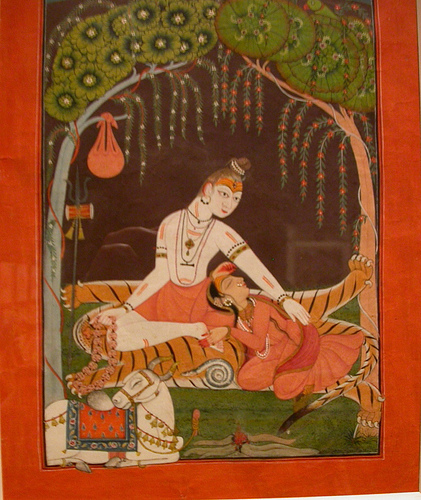
Shiva and Parvati at Night. @1700-1725. Shiva’s vehicle is a white zebu bull, here, asleep in the lower left.
“Fantastic and Functional Animals in Indian Art” at the Philadelphia Museum of Art is a parade of elephants, tigers, monkeys, birds, fish and ants depicted in delicious bright colors and detailed down to the last whisker. Better than a stroll through the zoo, this exhibit of 16th- through 19th-century Indian miniatures will feed your need to connect with all things furry and feathery. Some people get excited about flower shows. Others need their daily fix of Animal Planet. You know who you are.
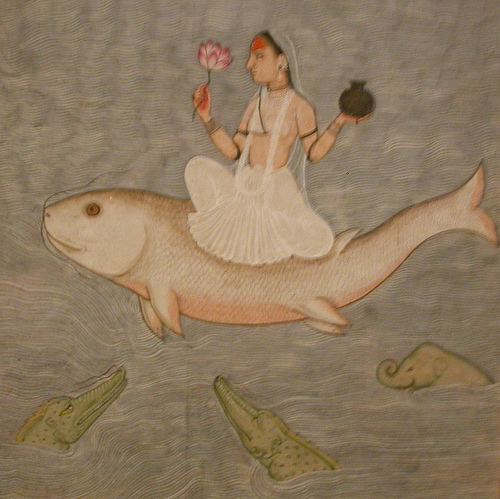
The Goddess Ganga (det). 1650-75. She personifies most important river in India. Here she rides an enormous rohu (carp). In the water are crocodiles and an elephant. In the sky are egrets flying.
With more than 30 works on display, the exhibit introduces heroic and magical animals like Hanuman the monkey-general and Kamadhenu the wish-granting cow. There are also more ordinary animal events. A Prince Restrains a Rampaging Elephant shows what must have been a regular occurrence: The pissed pachyderm rears up, the handlers flee, a horse cowers in fear. In spite of its stylized and dreamy depiction, the debacle looks incredibly realistic.
These animals are mostly anthropomorphic, or in some cases, metaphorical. But in all cases they remain animals. Hanuman the monkey-general is still obviously a monkey. The painters lived with animals, and they kept the depictions true to life. As anyone who lives with a pet knows, Poofy may be your best little friend, but she also needs her litter box cleaned.
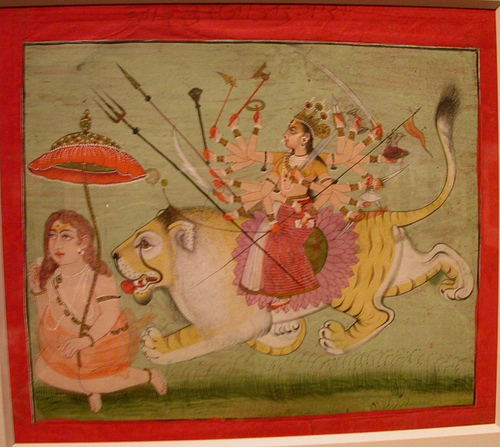
Great goddess as Ishwari, with Bhadrassguva. @1700-1725. Durga is the goddess. Her vehicle is an imagined feline — striped body of the tiger, tufted tail, short mane, face shape and color of a lion, facial tear lines of the cheetah.
Several drawings are on display for the first time, such as the pages from the Panchatantra. Like Aesop’s Fables, these Indian moral tales illustrate human life lessons with animals. My favorite is The Turtle Who Fell off the Stick. Two geese try to save two turtles from a drought by flying them to another lake. The turtles must hold onto a stick with their teeth, but one chatterbox opens his mouth to speak, and then falls to his death.
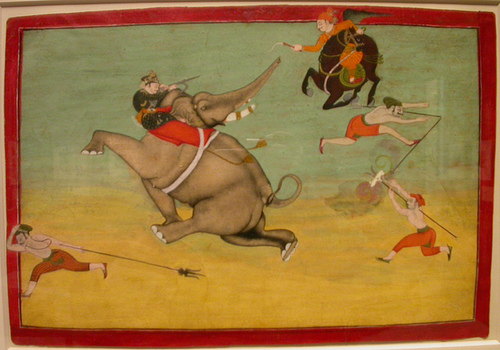
A Prince Restrains a Raging Elephant. @1780
Some of the best works show the Hindu gods riding their designated animal vehicles (vahanas). In Great Goddess as Ishwari With Bhadrassguva the multiarmed warrior goddess Durga rides to battle on an amalgam of three powerful cats (cheetah, lion and tiger). Ganga the Ganges river goddess rides a big white fish. In one tender scene Shiva is seen resting at night while his white bull vahana sleeps nearby.
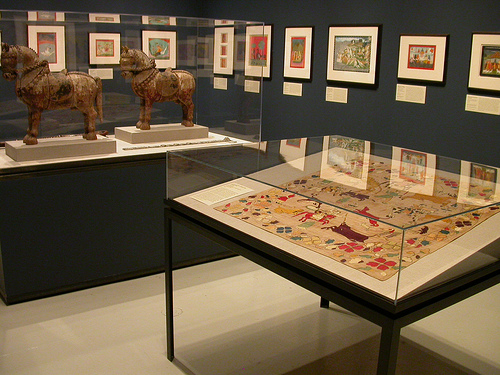
Installation shot. Indian miniatures on the wall, embroidered coverlet in vitrine and wood horses in other vitrine
Made so long ago, these works feel amazingly fresh. For more than a century Western art has prized abstraction and conceptual art over narrative. Thank goodness for Art Spiegelman, Gary Panter, Chris Ware and Philadelphia’s Charles Burns—graphic novelists who create sagas about people, animals and events of our times. They’re the closest living descendants of Indian miniature painters, and they’ll be the ones to provide a rich window to our world for future generations.
“Fantastic and Functional Animals in Indian Art”
Through June. Philadelphia Museum of Art, 26th St. and the Pkwy. 215.763.8100.









